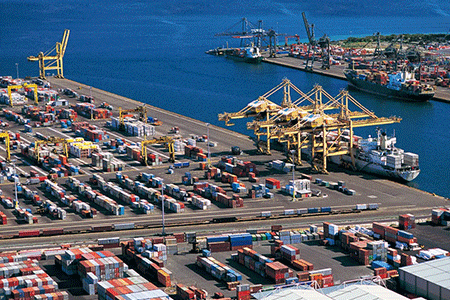1、 International logistics
International logistics refers to an international commodity transaction or exchange activity that physically moves materials in order to overcome the space and time distance between production and consumption when two or more countries are producing and consuming independently, so as to achieve the ultimate goal of international commodity transaction, that is, the seller delivers documents, goods and receives payment for goods, while the buyer accepts documents, pays for goods and receives trade convection conditions for goods.
1. Transport channel of international logistics
International maritime transport: It is carried out by natural channels.
International logistics transportation has two modes of operation: liner transportation and charter party transportation.
International railway transport: the transport of trade goods to other countries is international railway combined transport.
International road transport: refers to the transport process of transporting international goods across two or more countries or regions with the help of transport vehicles.
International air transport: a modern mode of transport, which uses transnational air carriers to handle the whole air transport between the two countries and undertake transport responsibilities.
Container transportation: container is the transportation unit, which is applicable to sea transportation and railway transportation.
2. Requirements for international logistics transportation of goods
Various modes of transport have their own reasonable scope of use and different transport characteristics. When selecting, they must be compared and comprehensively analyzed. Factors such as the nature, quantity, size of goods, distance of transport destination, urgency of market demand, and risk level need to be considered.
2、 Cross border e-commerce logistics
Cross border e-commerce logistics is the process of implementing and controlling the management of effective physical and information flow and storage plan with the customs of both countries as the destination. On this basis, cross-border e-commerce logistics is a logistics activity process that flows from cross-border e-commerce enterprises to cross-border consumers relying on the Internet, big data, informatization, computers and other advanced technologies.
1. The transportation channels of cross-border e-commerce logistics are the same as those of international logistics, including sea transportation, air transportation, rail transportation and land transportation (trucks, etc.).
2. Requirements for cross-border e-commerce logistics transportation of goods During the transportation of cross-border e-commerce logistics goods, imitations, infringing goods, flammable and explosive dangerous goods, liquids, powders, goods prohibited from export by the state, and products prohibited from import by other countries are not allowed to be transported, and the goods transported in the transportation must submit various safety certificates of the goods in compliance with the regulations.
In cross-border e-commerce logistics, most of them pursue timeliness. They can require cross-border e-commerce logistics companies to provide appropriate logistics transportation solutions according to the urgent demand cycle of goods, destination, quantity, size, etc. of the destination country.
What are the differences between international logistics and cross-border logistics?
1、 International logistics
International logistics refers to an international commodity transaction or exchange activity that physically moves materials in order to overcome the space and time distance between production and consumption when two or more countries are producing and consuming independently, so as to achieve the ultimate goal of international commodity transaction, that is, the seller delivers documents, goods and receives payment for goods, while the buyer accepts documents, pays for goods and receives trade convection conditions for goods.
1. Transport channel of international logistics
International maritime transport: It is carried out by natural channels.
International logistics transportation has two modes of operation: liner transportation and charter party transportation.
International railway transport: the transport of trade goods to other countries is international railway combined transport.
International road transport: refers to the transport process of transporting international goods across two or more countries or regions with the help of transport vehicles.
International air transport: a modern mode of transport, which uses transnational air carriers to handle the whole air transport between the two countries and undertake transport responsibilities.
Container transportation: container is the transportation unit, which is applicable to sea transportation and railway transportation.
2. Requirements for international logistics transportation of goods
Various modes of transport have their own reasonable scope of use and different transport characteristics. When selecting, they must be compared and comprehensively analyzed. Factors such as the nature, quantity, size of goods, distance of transport destination, urgency of market demand, and risk level need to be considered.
2、 Cross border e-commerce logistics
Cross border e-commerce logistics is the process of implementing and controlling the management of effective physical and information flow and storage plan with the customs of both countries as the destination. On this basis, cross-border e-commerce logistics is a logistics activity process that flows from cross-border e-commerce enterprises to cross-border consumers relying on the Internet, big data, informatization, computers and other advanced technologies.
1. The transportation channels of cross-border e-commerce logistics are the same as those of international logistics, including sea transportation, air transportation, rail transportation and land transportation (trucks, etc.).
2. Requirements for cross-border e-commerce logistics transportation of goods During the transportation of cross-border e-commerce logistics goods, imitations, infringing goods, flammable and explosive dangerous goods, liquids, powders, goods prohibited from export by the state, and products prohibited from import by other countries are not allowed to be transported, and the goods transported in the transportation must submit various safety certificates of the goods in compliance with the regulations.
In cross-border e-commerce logistics, most of them pursue timeliness. They can require cross-border e-commerce logistics companies to provide appropriate logistics transportation solutions according to the urgent demand cycle of goods, destination, quantity, size, etc. of the destination country.
